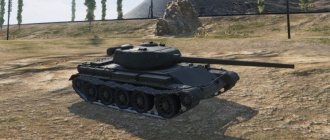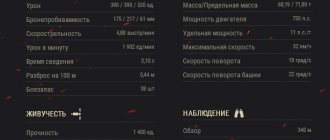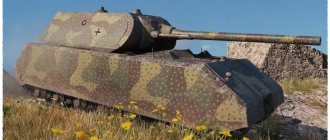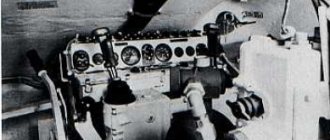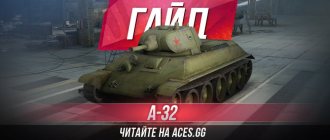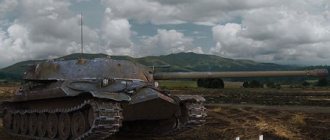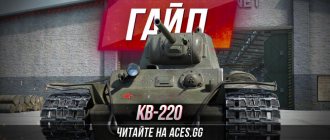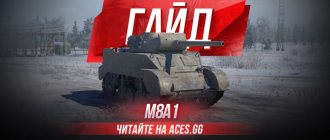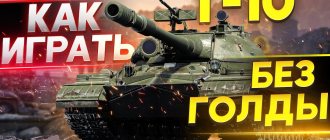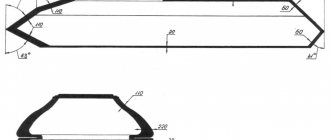The American T 34 is a heavy tank developed in the USA in 1945. It is a modernization of the T-30 tank. The history of this model began when the US military decided to equip one of the T-29 prototypes with the 120 mm cannon used in the T 53 model. The resulting hybrid was given the designation T 34, but later, after the end of World War II, work on modernization slowed down extremely. As a result, the T 34 prototype was never released.
Historical reference
At the beginning of 1945, in order to increase firepower, the Artillery Department decided to use the 120mm T53 anti-aircraft gun. During field tests, it was found that the characteristics of the gun were several times higher than the characteristics of the 105mm T5E1 and 155mm T7 guns. After passing various tests, the Artillery Department recommended installing this gun on two experimental T30 tanks.
After the gun was installed, it was decided to change the tank index and ultimately the new tank was called T34. According to the drawings, the tank was supposed to be equipped with a new, powerful engine from the T30 tank called Continental AV-1790. But it was decided to replace the engine from the T30 in order to reduce the costs of developing the T34 and supply a modified Allison V-171 aircraft engine. After installing a heavier gun, the balance of the tank was upset, so an armor plate 10.16 cm thick was welded to the rear of the turret, which restored the balance of the tank. The location of the internal modules remains almost the same as that of the predecessors T30 and T29.
120mm gun
The T 52 120 mm tank gun had separate loading. The ammunition stowage in the T 34 was located in the same way as in the T 29, T 30, but the baud caliber was slightly changed to a larger size. The mass of the test shot was 50 kg, the weight of the projectile was 23 kg. The entire ammunition load was designed for 34 rounds. The gun's rate of fire was 5 rounds per minute. In addition, the gun was equipped with a T143E2 telescopic sight and an M10E10 periscope sight. For firing from closed positions, the gun was equipped with a T19 azimuth, an M9 quadrant and an M1 gunner's quadrant. The only drawback of the new tank was the lack of gun stabilization.
Comparison of the T34 with other heavy premium tier 8 tanks
| Characteristics | T34 (USA) | Lowe (Germany) | IS-6 (USSR) | KV-5 (USSR) | M6A2E1 (USA) | FCM 50t (France) |
| Strength | 1500 HP | 1650 HP | 1550 HP | 1780 HP | 1500 HP | 1500 HP |
| Weight (t) | 71.85 t | 99.85 t | 59.9 t | 105 t | 70.5 t | 57.5 t |
| Engine power (hp) | 810 hp | 800 hp | 700 hp | 1200 hp | 960 hp | 1000 hp |
| Maximum speed (km/h) | 35 km/h | 35 km/h | 35 km/h | 40 km/h | 29 km/h | 51 km/h |
| Turning speed (deg/sec) | 22 °/s | 24 °/s | 26 °/s | 18 °/s | 24 °/s | 40 °/s |
| Hull armor (front/sides/stern in mm) | 102/76/51 mm | 120/80/80 mm | 100/100/60 mm | 180/150/140 mm | 191/44/41 mm | 120/80/80 mm |
| Turret armor (front/sides/rear in mm) | 279/127/203 mm | 120/80/80 mm | 150/150/100 mm | 180/150/140 mm | 191/89/208 mm | 120/80/60 mm |
| Basic projectile damage | 400/400/515 HP | 320/320/420 HP | 390/390/465 HP | 300/300/360 HP | 320/320/420 HP | 240/240/320 HP |
| Armor penetration with basic projectile (mm) | 248/297/60 mm | 234/294/60 mm | 175/217/61 mm | 167/219/54 mm | 198/245/53 mm | 212/259/45 mm |
| Gun rate (rounds/min) | 4 min-1 | 5 min-1 | 5.13 min-1 | 7 min-1 | 5.05 min-1 | 8 min-1 |
| Turret rotation speed (deg/sec) | 18 | 23 | 24 | 21.25 | 23 | 36 |
| Review (m) | 360 m | 400 m | 350 m | 350 m | 380 m | 400 m |
| Communication range (m) | 745 m | 710 m | 440 m | 440 m | 570 m | 750 m |
Pros:
- Excellent UGN
- Excellent armor penetration
- High one-time damage
Minuses:
- Low rate of fire
- Very long mixing
- Weak hull armor
- Short viewing range.
Technical characteristics of the American T-34
| Total information | ||
| crew | 6 people | |
| length with gun forward | 11.0871 m | |
| travel length with gun | 10.11428m | |
| length without gun | 7.60984 m | |
| gun reach | 4.16306m | |
| width with flaps | 3.80238 m | |
| height with commander's cupola | 3.22326 m | |
| track: with 28-inch tracks with 23-inch tracks | 2.921 m2.794 m | |
| clearance | 0.47752m | |
| firing line height | about 2.159 m | |
| turret shoulder strap | 2.032 m | |
| weight, combat | 65.1358643 kg | |
| weight, empty | 61.053533 kg | |
| specific power: normalmaximum | 9.8 hp/ton 11.3 hp/ton | |
| ground pressure: with 28" tracks with 23" tracks | 12.4 inches/sq. inch15.1 inch/sq. inch | |
| Armor | |||||
| armor | forehead | board | stern | top | bottom |
| frame | 70 mm > 58° | 76 mm > 0° (front) 51 mm > 0° (rear) | 19 mm > 62° | 38 mm > 90° | 25 mm >90°(front);13 mm >90°(rear) |
| superstructure | 102 mm > 54° | 51 mm > 9° | – | ||
| tower | 178 mm > 0° | 127 mm > 0° | 203 mm > 0° | 38 mm > 90° | – |
| mask | 203 – 279 mm > 0° | ||||
| armor type | tower – cast homogeneous steel; body – rolled and cast homogeneous steel | compound | welding | ||
| The angle of inclination of the armor is calculated from the vertical | |||||
| Armament | ||
| 120 mm Gun E53 on a T125 carriage in the turret | ||
| traverse | 360°, electro-hydraulic and manual | |
| turret traverse speed (maximum) | 20 sec / 360° | |
| elevation | from +15° to -10° | |
| rate of fire (maximum) | 5 rounds per minute (with 2 loaders) | |
| loading | manual | |
| stabilization system | No | |
| (1) .50 caliber MG HB M2 – flexible anti-aircraft turret mount (2) .50 caliber MG HB M2 – twin (1) .30 caliber MG M1919A4 – directional | ||
| Ammunition | ||
| 34 shots for 120mm cannon | ||
| 2090 rounds for .50 caliber | ||
| 1080 rounds for .45 caliber | ||
| 2050 rounds for .30 caliber |
| Fire control system and surveillance devices | ||
| main weapon | ||
| for direct shooting | telescopic sight T143E2 periscopic sight M10E10 | |
| for indirect shooting | Azimuth indicator T19 vertical guidance quadrant M9 gunner's quadrant M1 | |
| surveillance devices | ||
| straight | indirect | |
| driver | Luke | periscope M13 (1) |
| driver's assistant | Luke | periscope M13 (1) |
| commander | viewing blocks (6) in the commander's cupola, hatch | periscope M15 (1) |
| gunner | No | periscope M10E10 (1) |
| left loader | Luke | No |
| right loader | hatch, pistol loop | No |
| Engine | ||
| manufacturer and model | Continental AV-1790-3 | |
| type | 12 cylinders, 4-stroke, V-shaped 90° | |
| cooling | air | |
| ignition | magneto | |
| volume | 1791.7 cubic inches | |
| piston | 5.75 x 5.75 inches | |
| specific pressure | 6.5:1 | |
| normal power (maximum) | 704 hp / 2800 rpm | |
| highest power (maximum) | 810 hp / 2800 rpm | |
| ordinary torque (maximum) | 1440 ft lb/2000 rpm. | |
| greatest torque (maximum) | 1610 ft lb / 2200 rpm. | |
| weight | 2332 lbs. dry | |
| fuel | 80 octane gasoline, 320 gallons | |
| engine oil | 72 quarts | |
| Power transmission | ||
| transmission | cross drive CD-850-1, 2 forward speeds, 1 reverse | |
| ratio | 12.7:1 top 6.2:1 bottom20.6:1 back | |
| steering | mechanical, joystick-type steering lever, 5.7 rpm. | |
| brakes | disk | |
| main gear | spur gear, 6.31:1 | |
| drive wheel | rear, 15 teeth, diameter - 28.89 inches | |
| Chassis | ||
| suspension | torsion bar, 16 road wheels with individual suspension (8 per track) | |
| bandage size | 26 x 6 inches | |
| support rollers | 14 (7 per track) | |
| guide wheel | ahead on every track | |
| idler wheel size | 26 x 6 inches | |
| shock absorbers | on the first 3 and last 2 rollers on each side | |
| caterpillars* | T80E3 – double ridge, 28 inches wide, rubber-metal T84E3 – double ridge, 28 inches wide, with rubber chevron | |
| step | 6 inches | |
| total tracks | 204 (102 per track) | |
| track reference length | 204.6 inches left208.6 inches right | |
| *T80E3 and T84E3 tracks are 23" wide T80E1 and T84E1 tracks with 5" spurs | ||
| Electrical system | ||
| Rated voltage | 24 volts DC | |
| main generator | 28.5 volts, 200 amps, main engine power take-off | |
| auxiliary generator | 28.5 volts, 200 amps, powered by auxiliary motor | |
| batteries | 2 pieces, 12 volts | |
| Means of communication | ||
| radio | SCR 508 or 528 in turret basket | |
| interphone | 6 stations and external additional output RC-298 | |
| Fire protection system | ||
| 3 fixed 10 lb carbon monoxide extinguishers 2 separate 5 lb carbon monoxide extinguishers |
| Driving performance | ||
| highest speed | 22 mph, highway | |
| tractive effort | 91,700 lbs64% of vehicle weight | |
| incline | 60% | |
| ditch | 6.25 feet | |
| wall | 26 inches | |
| ford | 42 inches | |
| smallest turning diameter | around its axis | |
| power reserve | about 100 miles by highway | |
Penetration zones of the T34 tank
Today we will penetrate T34 with a 122 mm D2-5T gun mounted on a KV-1S tank.
(Image is clickable)
During the test, it was revealed that it is practically impossible to blow up the ammunition rack or destroy the engine, they are very strong. By shooting at the “star,” you will concuss the loader, and a little closer to the gun, the gunner. It is also worth noting that the tank is very “random”. The gunner almost never criticizes the side of the turret (1 time out of 10 attempts), but the first time he hits the cheek of the turret when meeting a tank head-on, but do not forget that he is sitting to the left of the gun. The commander has the same problem; he gets criticized on the side of the turret 7 times out of 10, and on the forehead 5 times out of 10.
(Image is clickable)
When shooting a tank head-on (at the machine gun nest), there is a chance of concussing the radio operator, and on the opposite side of the VLD (slightly to the left of the headlight) - the driver.
Disadvantages of T34
- Low speed and maneuverability.
The tank accelerates poorly and turns even worse. Because of this, you must formulate a picture of the battle in your head in advance so that you can be in the right place at the right time. - There is no armor in the hull.
The frontal projection of the tank is poorly protected, even tanks at a lower level can easily exchange their strength with the T34 and this can only be prevented by the correct selection of position. - Long mixing. This makes it difficult to fight against fast targets. Long convergence is difficult to correct, so you will have to learn to predict the line of movement of enemy light tanks.
Tips for playing tactics on T34
Don’t forget about our rate of fire, because without any “bonuses” our tank will be shot at in any case. Therefore, you should not shoot in an open field. When playing on T34, you need to know the terrain and various shelters on this map well, because shelters are everything to us. Our tank is a support tank and is located in the second line.
Also, you should not remember about the golden rule - “A killed friend is a best friend,” because there is nothing better than a personal shelter, which you can also move at your discretion. Our tower is strong and impenetrable for many, so playing through the tower is a Must Have.
Since the viewing range of our tank is small, you need to take a comrade in a platoon on a medium tank (T-44), who will highlight the enemies for you, and you can calmly deal damage.
Advantages of T34
- Impenetrable tower.
The tank is able to withstand any hits to the tower, which allows it to hold its position well on many maps and makes it an excellent support. - Low spread.
Compared to similar heavy tanks, the T34 has good accuracy, which can be improved with equipment. As a result, during positional firefights, he is able to precisely target enemy vulnerabilities. - High armor penetration.
It is enough to shoot at the silhouette of most tanks. It is not enough only for the most powerful “mastodons” from the German branch, and the turrets of Swedish heavy tanks from the “Emil” branch.
T34 Heavy tank
Official designation: T34 Heavy Tank Alternate designation: Start of design: 1944 Date of construction of the first prototype: 1946 Stage of completion: one prototype built.
In the history of world tank building, there were three tanks with the T-34 index of different classes and periods of construction. They were two Soviet tanks (“mobilization” model 1932 and medium model 1940-1945) and one American heavy tank. The latter had the T34 index and belonged more to the “assault” class, having a very wide range of actions, from fighting enemy armored vehicles to suppressing long-term fortifications. The history of this combat vehicle, which never made it out of the experimental stage, began in March 1944, when the Ordnance Department issued a specification for a heavy tank that was superior to the then-available M26 in armament and armor. A year later, one prototype of the T29 and T30 tanks was assembled, mostly differing only in the type of gun, but neither one nor the other could fully satisfy the requirements of the military. Then a proposal was made to equip one of the T29 prototypes with a T53 type gun of 120 mm caliber.
As experimental firing showed, this artillery system had better armor penetration compared to the 105 mm T5E1 and 155 mm T7. For example, the T20E3 armor-piercing projectile (total mass 23 kg) with an initial speed of 945 m/s at a distance of 914 meters pierced an armor plate 198 mm thick, installed at an angle of 30°; As the distance increased to 1829 meters, this figure decreased to 173 mm, but even in this case, the projectile was guaranteed to penetrate the armor of any German tank. The HVAP-type sub-caliber round, developed for the 120-mm T53 gun, had even more impressive characteristics. Having an initial speed of about 1249 m/s, under the above conditions, the projectile penetrated armor with a thickness of 381 mm and 318 mm, respectively. True, with an increase in the slope of the armor to 60°, armor penetration seriously deteriorated and was already 112 mm and 76 mm. However, the performance looked impressive and in mid-1945 work began on installing the T53 gun on the T29 tank. After the changes, the new car began to be designated as T34
. It was originally planned that the tank would be equipped with a Ford GAC engine, but these plans were soon changed.
Structurally, both models were almost identical, with the exception of details regarding the new artillery system. Externally, the T34 differed from the T29 only in the gun barrel. The tank hull was made of homogeneous armor sheets. Priority in protection was given to the frontal part, where the armor thickness was 70-102 mm. The sides were made of 51-76 mm armor plates, the stern - 19-51 mm. The thickness of the bow of the bottom was increased to 38 mm - the hull roof had a similar thickness. The body layout is classic. The chassis, for one side, consisted of the following elements:
— 8 rubberized road wheels, individual suspension, torsion bar, tire size 26x6 inches;
— 7 supporting wheels;
— front guide wheel, bandage size 26x6 inches;
— rear drive wheel with 15 rims with a diameter of 28.89 inches (734 mm);
- rubber-metal double-ridge caterpillar track with T80E3 type tracks 711 mm wide and 152 mm pitch, total number of tracks - 204 pcs.
A Continental AV-1790-3 V-shaped 12-cylinder gasoline engine was installed in the engine-transmission compartment, developing a maximum power of 810 hp at 2800 rpm. and nominal 704 hp. The engine displacement was 1791.7 cubic inches. Fuel (80 octane gasoline) was stored in a tank with a capacity of 320 gallons (1211 liters).
The CD-850-1 type transmission had two forward speeds, one reverse speed and disc brakes. Gear ratios were 12.761, 6.2:1 and 20.6:1 respectively. The main gear was spur-cut, cylindrical, with a gear ratio of 6.31:1. The tank was controlled using a joystick-type steering lever.
The electrical system used two 28.5-volt generators, producing a nominal voltage of 24 volts DC. The main generator was powered by the main engine, and the auxiliary generator by the spare one. The tank was also equipped with two 12-volt batteries. Electricity was supplied to interior lighting devices, phases, side lights and communications equipment. As standard, the tank was equipped with a radio station SCR 508 or SCR 528 and an intercom for 6 subscribers with an external output of the RC-298 type. The fire extinguishing system used three 10-pound stationary and two 5-pound portable fire extinguishers filled with a mixture of carbon monoxide.
The viewing devices were very varied. For direct shooting, the gunner could use the T143E2 telescopic sight and the M10E10 periscopic sight. For firing from closed positions, the following sighting equipment was used: T19 azimuth indicator, M9 vertical guidance quadrant and M1 gunner's quadrant. The driver and assistant driver were equipped with M13 periscope devices. The commander's cupola had six prismatic viewing devices. In addition, the commander had at his disposal an M15 periscope installed in the turret hatch.
The main armament, which, as mentioned earlier, consisted of a 120-mm T53 gun with separate case loading on a T125 carriage, was placed in a cast turret with a shoulder strap of 2.032 meters. Vertical guidance angles varied from -10° to +15°; The turret could be rotated using an electro-hydraulic or manual system. It turned 360° in 20 seconds. The maximum rate of fire was 5 rounds per minute.
As usual, the turret armor was particularly strong and varied along vertical surfaces from 127 to 203 mm. The thickness of the gun mantlet armor was 203-279 mm. To the left of the gun, two 12.7-mm Colt-Browning M2HB machine guns were mounted, and another similar machine gun was mounted on the roof of the turret as an anti-aircraft gun. On the right, one 7.62-mm Colt-Browning М1919А4 machine gun was installed in the frontal plate of the hull. The package carried six Thompson submachine guns of 11.43 mm caliber. The total ammunition included:
— 34 shots for a 120 mm cannon
— 2090 rounds for 12.7 mm machine guns
— 1080 rounds for 11.43 mm Thompson assault rifles
— 2050 rounds for a 7.62 mm machine gun.
The tank's crew consisted of 6 people: the driver and assistant driver were located in the control compartment in the front part of the hull, and the positions of the commander, gunner and two loaders were in the turret.
It would seem that no difficulties should have arisen when converting the T29 into the T34, but problems began immediately after the attempt to install the gun. As it turned out, to balance it was necessary to add a counterweight - this task was completed quickly, but while the work was underway, the war ended. Testing of the T34 prototype began only in 1946. The tank was transferred to the training ground at Fort Knox, where it was “tested” by military tank crews.
During the fire tests, it turned out that after a shot there was a big problem with gas contamination in the fighting compartment. Two fans could no longer cope with the powder gases of the powerful weapon. Then, such an unpleasant thing as a “reverse flash” was discovered - for this reason, two people were hospitalized in Fort Knox alone, and during tests in Aberdeen, several tankers had their eyebrows and hair burned. As you might guess, the reason for this was the same unburnt completely powder gases, which were drawn into the turret during the extraction of the cartridge case and, mixing with oxygen, caused re-ignition. The first attempt to install a compressor in the fighting compartment for purging the barrel was unsuccessful, and then a smoke suction device was installed on the gun barrel, as was done previously for the 90-mm T15E4 and M3E4 guns. The solution turned out to be very successful and was subsequently used on other American tanks, but the fate of the experimental T34 was already sealed. At the end of the 1940s. The Ordnance Department has revised plans for tanks based on the T29, significantly reducing their construction program. In fact, the matter was limited to only “pilot” and experimental models, after which almost all manufactured samples were scrapped. The only prototype of the T34 tank has not survived to this day and was cut into metal.
Sources: “British and American tanks of the Second World War” by P. Chamberlain and K. Alice. AST\Astrel. Moscow. 2003 P.Chamberlen and C.Ellis “British and American Tanks of World War Two”, Silverdale Books, 2004 RPHunnicutt “A History Of The American Heavy Tank” Feist Publications, 1987 RJIcks “A History Of The American Heavy Tank”, AFV Weapons Profile, No. 41 Para Bellum: Heavy tank T34 Armored site: American heavy tanks
TACTICAL AND TECHNICAL CHARACTERISTICS OF THE T34 HEAVY TANK, model 1945.
| COMBAT WEIGHT | 61053 kg (empty) 65136 kg (full) |
| CREW, people | 5 |
| DIMENSIONS | |
| Length, mm | 11087 (with gun) 7610 (hull) |
| Width, mm | 3803 |
| Height, mm | 3223 |
| Ground clearance, mm | 478 |
| WEAPONS | one 120 mm T53 cannon, three 12.7 mm Colt-Browning M2HB machine guns, one 7.62 mm Colt-Browning M1919A4 machine gun and six 11.43 mm Thompson machine guns |
| AMMUNITION | 34 rounds for a 120 mm gun 2200 rounds for a 12.7 mm machine gun 2500 rounds for a 7.62 mm machine gun 1080 rounds for an 11.43 mm machine gun 12 hand grenades |
| AIMING DEVICES | binocular sight T143E1, periscope M10E9, viewing devices M15 Plus and M13, azimuth indicator T19, vertical guidance quadrant M9 and gunner's quadrant M1 |
| RESERVATION | hull forehead (top) - 102 \ 54° hull forehead (bottom) - 70 \ 54° sides (front) - 76 \ 0° sides (rear) - 51 \ 0° stern (top) - 51 \ 9° stern (bottom) - 19\0° hull roof - 38\90° bottom (front) - 25\90° bottom (rear) - 13\0° gun mantlet - 203-279\0° turret forehead - 178\0 ° turret side — 127 \ 0° turret rear — 102 \ 0° turret roof — 38 \ 90° |
| ENGINE | Continental AV-1790-3, gasoline, 12-cylinder, maximum power 810 hp. at 2800 rpm, fuel reserve 1211 liters |
| TRANSMISSION | CD 850-1, mechanical type 3-speed gearbox, disc brakes |
| CHASSIS | (on one side) 8 rubberized road wheels with individual torsion bar suspension, 7 support wheels, front idler wheel, rear drive wheel, T80E1 large-link caterpillar with tracks 711 mm wide and 152 mm pitch |
| SPEED | 35.4 km/h on the highway |
| HIGHWAY RANGE | 121 km |
| OBSTACLES TO OVERCOME | |
| Elevation angle, degrees. | 60° |
| Wall height, m | 0,66 |
| Fording depth, m | 1,067 |
| Ditch width, m | 2,60 |
| MEANS OF COMMUNICATION | radio station SCR 508 or SCR 528 and intercom for 6 subscribers with external output type RC-298 |
Equipment, equipment and ammunition
T34 is a TT, which means you need to install ventilation, a rammer and a vertical stabilizer. Or, instead of a rammer, as an option, a lining is placed on the tank. In this case, 0.9 seconds are lost. charging with each shot, in total it is 5.6 seconds. charging delay per minute. This then adds up to 600kg of extra weight when compared to the rammer. Decide for yourself what is more important.
Equipment: first aid kit, repair kit and fire extinguisher will provide everything you need in a difficult situation.
The ammunition load of 34 rounds is quite sufficient, even for very active combat. The proportion - 24\3\8 - is what is needed for combat. 3 sub-calibers give penetration to a heavily armored target. 8 HE shell finishes off any tank. 24 simple armor-piercing ones will finish off any enemy.
The T34 is a TT, so quick repairs to the tracks, guns, turret and other modules will be of great importance.
Application
Well suited for offensive actions or shooting at someone else's light. In close combat without the support of allies, the tank becomes defenseless due to the long reload time.
The huge dispersion of the gun on the move, combined with the low aiming speed, does not make it possible to quickly open fire after stopping or moving out from behind cover.
T34 can be used as a tank destroyer. To do this, we have a fairly accurate gun with high armor penetration and a thick turret through which we can successfully tank. The T34 is most effective in a group of allied tanks at medium-long range.
The clinch is especially worth noting. Unlike the T32, the small size of the gun mantlet and the height of the T34 make this type of close combat ineffective. At close range, the enemy can easily hit the thin body.
The accuracy of the gun allows you to shoot at distant targets, and high damage will make it possible to destroy most targets in 2-3 shots.
